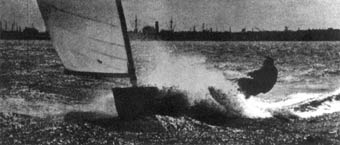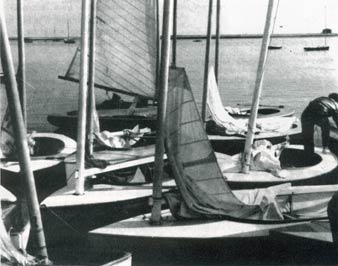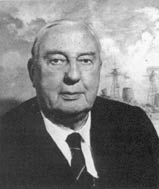| 17. History
of the Finn Gold Cup |
by
Peter Mohilla and Robert Deaves
|
|
Until 1956, the centre of Finn sailing was in the Scandinavian countries,
mainly Sweden. Other countries introduced a few Finn dinghies only
because it was used at the Olympic Games in order to give their top
single-handed helmsmen an opportunity to become familiar with the
peculiarities of the Finn. One of these nations was the United Kingdom
where the first privately owned Finns were built as early as 1951.
The driving force were the Stratton brothers Vernon and Desmond.
|
 |
|
In 1956 Vernon Stratton,
later to become editor of Finnfare, secretary and finally president of the
IFA, induced F.G. Mitchell of the Royal Corinthian Yacht Club, Burnham-on-Crouch
(Great Britain) to present a Gold Cup to the Finn Class. This Gold Cup was
to be held for one year by the winner of a competition that quickly turned
into the World Championship of the Finn Class. Originally the Gold Cup was
intended by the donor to be organised once every four years in Great Britain.
The first Gold Cup took place in Burnham at the club of F.G. Mitchell in
1956. Four and eight years later it was sailed in Torquay UK. In 1968 it
was organised in Kent UK, an unsuitable area with very strong tide and currents,
which caused strong opposition by many nations to organise it once every
four years in Great Britain any more. Instead it was decided to have it
at least once every four years outside of Europe. Thus the event was staged
in Bermuda in 1969, in Toronto, Canada in 1971, in Long Beach, USA in 1974,
in Brisbane, Australia in 1976. Manzanillo, Mexico 1978, Auckland, New Zealand
1980, Milwaukee, USA 1983, Ilha Bela, Brazil 1988, Kingston, Canada 1991
and Melbourne, Australia in 1995 and 1999. |
In 1970 at Cascais, Portugal, Jorg Bruder of Brazil won the Cup over
the largest Finn fleet ever gathered (180 boats) and defended it successfully
in 1971 at Toronto, Canada and Anzio, Italy in 1972. On his way to
Brest, France where he was to defend the Cup once more, fate decided
that he would remain unbeaten forever. Bruder died in an air crash
on July 11th, 1973 and the original Gold Cup was lost.
|
 |
In 1975 Gilbert Lamboley induced Somms Marine, a French Company which is well known for its support of Yachting, to donate a replica of the Cup. The contract that
passed between this company and the representative of the Class, created
only discrete obligations on the Class. It was approved by the IYRU. The
rales for the championship and for the final destiny of the Cup remained
unchanged.
The Gold Cup is the most important part of the history of the Finn Class.
The formation of the IFA on August 23, 1956 in Loosdrecht, Holland was strongly
influenced by the first Gold Cup in March/April 1956 at Burnham-on-Crouch,
England. From then on the Annual General Meeting of the IFA was generally
held at the time and place of the Gold Cup. Therefore the sporting and administrative
climax of each year coincided at the Gold Cups. Also the Gold Cup races,
together with the European Championships, turned out to be the best indicator
for any new technical development of the Finn Class.
In the beginning there was no limitation of numbers of entries to the Gold
Cup. Because of the difficulties at the starting lines in 1961 and 1962,
the number of participants in the 1963 Gold Cup in Medemblik was limited
to 15 boats per nation. In 1964 at Torquay there were 10 entries per nation
allowed. In 1964 the idea was considered to have the Gold Cup divided into
two weeks of racing, one week of eliminations and a second week with those
qualified, but the idea was finally rejected. By 1965 it was agreed to allow
again 15 boats per nation. In 1969 in Bermuda a new regulation was decided
upon. A basic quota of 3 boats was granted to each member country, plus
1 entry for each 25 paid IFA dues, up to a maximum of 15 boats per nation.
In 1971 this system was altered, the minimum being 2 boats per nation. |
In 1973 the IYRU tried to reduce the number of entries to 60 boats
but the IFA refused. The system remained unchanged and national secretaries
were allowed to enter above the national quota in addition. By 1974
it was agreed, that the top 10 individual finishers of the previous
Gold Cup are allowed to enter above the national quota. The proportional
system, relating number of paid IFA dues to the number of entries
to the Gold Cup and the European Championship was changed again in
1977. By 1978 the IYRU tried again to enforce a limitation of 60 boats,
but the IFA decided it would try to find a way to circumvent this
rule.
|
 |
| The
Finn Gold Cup |
In 1980 the proportions between number of IFA fees paid and number of entries
allowed was changed once again. In 1982 it was decided that the number of
places should be linked to the average number of the fees paid for in the
last three years. Later this was changed back to the fees paid in the current
year only. In 1997 a 'Rookie' place was introduced, available to any helm
from a paid up nation who had never competed in a Gold Cup or Europeans
before.
|
In the first 5 Gold Cups 1956-1960 only wooden boats were allowed.
When GRP was permitted in 1961 and plastic boats ended up 1st, 2nd
and 3rd, the Finn class ran into a severe crisis. Many owners of older
wooden boats were afraid that their equipment had been totally outmoded.
In addition Arne Akerson won the 1962 event with the boat of Fred
Miller jr., which Rickard Sarby found to behave very different from
an ordinary Finn dinghy in waves. The measurement committee of the
1962 Gold Cup found several kilos of hidden lead in that magic boat,
a fact which raised further objections against plastic boats. It was
felt, that it was too easy to cheat in GRP. Then in 1964 Hubert Raudaschl
won the Gold Cup in his home made wooden boat and thus turned back
the wheel of Finn development for almost a decade. After two years
of experimenting with his own GRP development, Willy Kuhweide bought
back his old wooden Finn and won the Gold Cup twice. After Raudaschl
and Kuhweide, the late Jorg Bruder also used wooden hulls to demonstrate
the qualities of this traditional material.
|
 |
The
boats at the 1956 Gold Cup. In the centre,
Paul Elvstrom's Bess |
In the mid seventies
GRP hulls with soft wooden decks proved to be most successful.Then from
the late seventies, full GRP hulls, mainly Vanguards, were dominant in Gold
Cups. In the early nineties, the arrival of a variety of modern well thought
out hulls broke the Vanguard monopoly. Lawrence Lemieux developed his own
hulls (which Hans Spitzauer won the 1995 Gold Cup in), Pata Boats from Hungary
also brought out a new hull, but the most dominant numerically was the Devoti,
which first won the Gold Cup in 1993 with Philippe Presti helming. Developed
by Tim Tavinor and Luca Devoti, the hull was chosen for the 1996 Olympics
in Savannah and has virtually dominated the Finn fleet ever since. |
With regard to masts the development was less confusing. The traditional
wooden masts were outmoded by special wooden Bruder spars by 1969.
In that same year Jack Knights showed up with an aluminium spar at
the Gold Cup in Bermuda for the first time. In 1972 Jorg Bruder himself
won the Gold Cup with his own aluminium mast. From then on only aluminium
masts were used by the winners of the Gold Cup, and Needlespar masts
gained a complete domination of the Finn market. When carbon was first
allowed in 1993, masts made from this new material soon found popularity
as well as boatspeed. Within a short time virtually all competitors
were using carbon masts. In 1995 Hans Spitzauer was the first sailor
to win the Gold Cup with a wing mast.
With regard to sails, up to 1959 only cotton was allowed. Thereafter
Dacron was used exclusively. In the late sixties Raudaschl sails dominated
Finn events in combination with Bruder masts. In the late seventies
early eighties North sails gained a similar dominance which lasted
through to the nineties. In 1998, modern materials such as Kevlar,
Mylar, polyester and even monofilm were starting to be used and it
wasn't long before sails made from these new 'hard' cloths were dominant
on the water as well as in numbers.
|
 |
| F.
R. 'Tiny' Mitchell |
Outstanding individuals in the history of the Gold Cup are:
Jorg Bruder of Brazil won the Cup three times consecutively in 1970/1971/1972
and was second in 1966 and 1969, Willy Kuhweide of FRG three times in 1963/1966/1967,
Lasse Hjortnas three times in 1982/1984/1985. Andre Nelis of Belgium won
the Cup twice in 1956/1961, was second three times in 1958/1959/1960, and
third twice in 1957/1962, thus he finished seven years among the top three.
Fredrik Loof has so far won the Gold Cup three times, in 1994/1997/1999,
was second in 1993/1995/1998 and was third in 1996, and therefore is the
most successful participant in the Finn Gold Cup up to the present time.
F.R. 'Tiny' Mitchell, donor of the Finn Gold Cup, died in England during
November, 1962. Until he presented the Gold Cup, in 1956, upon the suggestion
of Vernon Stratton, there was no real basis for the International Finn Class
although many boats existed in several countries. There is no question that
the Cup and its deed of gift were the first instruments which in fact created
the IFA, as it brought all nations together for a week of meeting and racing.
Without 'Tiny' Mitchell, it is not believed that Finn racing would be on
such a firm footing internationally as it is now.
|
|